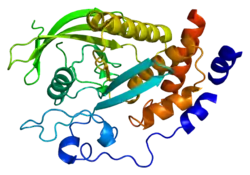PTPN14
Tyrosine-protein phosphatase non-receptor type 14 is an enzyme that in humans is encoded by the PTPN14 gene.[5][6]
| PTPN14 | |||||||||||||||||||||||||||||||||||||||||||||||||||
|---|---|---|---|---|---|---|---|---|---|---|---|---|---|---|---|---|---|---|---|---|---|---|---|---|---|---|---|---|---|---|---|---|---|---|---|---|---|---|---|---|---|---|---|---|---|---|---|---|---|---|---|
 | |||||||||||||||||||||||||||||||||||||||||||||||||||
| |||||||||||||||||||||||||||||||||||||||||||||||||||
| Identifiers | |||||||||||||||||||||||||||||||||||||||||||||||||||
| Aliases | PTPN14, PEZ, PTP36, protein tyrosine phosphatase, non-receptor type 14, CATLPH, protein tyrosine phosphatase non-receptor type 14, PTPD2 | ||||||||||||||||||||||||||||||||||||||||||||||||||
| External IDs | OMIM: 603155 MGI: 102467 HomoloGene: 3941 GeneCards: PTPN14 | ||||||||||||||||||||||||||||||||||||||||||||||||||
| |||||||||||||||||||||||||||||||||||||||||||||||||||
| |||||||||||||||||||||||||||||||||||||||||||||||||||
| |||||||||||||||||||||||||||||||||||||||||||||||||||
| |||||||||||||||||||||||||||||||||||||||||||||||||||
| Wikidata | |||||||||||||||||||||||||||||||||||||||||||||||||||
| |||||||||||||||||||||||||||||||||||||||||||||||||||
Function
The protein encoded by this gene is a member of the PTP family and PTPN14 subfamily of tyrosine protein phosphatases. PTPs are known to be signalling molecules that regulate a variety of cellular processes including cell growth, differentiation, mitotic cycle, and oncogenic transformation. This PTP contains an N-terminal noncatalytic domain similar to that of band 4.1 superfamily cytoskeleton-associated proteins, which suggested the membrane or cytoskeleton localization of this protein. The specific function of this PTP has not yet been determined.[6]
Interactions
PTPN14 has been shown to interact with Beta-catenin.[7]
References
- GRCh38: Ensembl release 89: ENSG00000152104 - Ensembl, May 2017
- GRCm38: Ensembl release 89: ENSMUSG00000026604 - Ensembl, May 2017
- "Human PubMed Reference:". National Center for Biotechnology Information, U.S. National Library of Medicine.
- "Mouse PubMed Reference:". National Center for Biotechnology Information, U.S. National Library of Medicine.
- Smith AL, Mitchell PJ, Shipley J, Gusterson BA, Rogers MV, Crompton MR (Apr 1995). "Pez: a novel human cDNA encoding protein tyrosine phosphatase- and ezrin-like domains". Biochemical and Biophysical Research Communications. 209 (3): 959–65. doi:10.1006/bbrc.1995.1591. PMID 7733990.
- "Entrez Gene: PTPN14 protein tyrosine phosphatase, non-receptor type 14".
- Wadham C, Gamble JR, Vadas MA, Khew-Goodall Y (Jun 2003). "The protein tyrosine phosphatase Pez is a major phosphatase of adherens junctions and dephosphorylates beta-catenin". Molecular Biology of the Cell. 14 (6): 2520–9. doi:10.1091/mbc.E02-09-0577. PMC 194899. PMID 12808048.
Further reading
- Gyapay G, Morissette J, Vignal A, Dib C, Fizames C, Millasseau P, Marc S, Bernardi G, Lathrop M, Weissenbach J (Jun 1994). "The 1993-94 Généthon human genetic linkage map". Nature Genetics. 7 (2 Spec No): 246–339. doi:10.1038/ng0694supp-246. PMID 7545953. S2CID 24662426.
- Ogata M, Takada T, Mori Y, Oh-hora M, Uchida Y, Kosugi A, Miyake K, Hamaoka T (Apr 1999). "Effects of overexpression of PTP36, a putative protein tyrosine phosphatase, on cell adhesion, cell growth, and cytoskeletons in HeLa cells". The Journal of Biological Chemistry. 274 (18): 12905–9. doi:10.1074/jbc.274.18.12905. PMID 10212280.
- Ogata M, Takada T, Mori Y, Uchida Y, Miki T, Okuyama A, Kosugi A, Sawada M, Oh-hora M, Hamaoka T (Jul 1999). "Regulation of phosphorylation level and distribution of PTP36, a putative protein tyrosine phosphatase, by cell-substrate adhesion". The Journal of Biological Chemistry. 274 (29): 20717–24. doi:10.1074/jbc.274.29.20717. PMID 10400706.
- Aoyama K, Matsuda T, Aoki N (Dec 1999). "Characterization of newly identified four isoforms for a putative cytosolic protein tyrosine phosphatase PTP36". Biochemical and Biophysical Research Communications. 266 (2): 523–31. doi:10.1006/bbrc.1999.1845. PMID 10600535.
- Wadham C, Gamble JR, Vadas MA, Khew-Goodall Y (Sep 2000). "Translocation of protein tyrosine phosphatase Pez/PTPD2/PTP36 to the nucleus is associated with induction of cell proliferation". Journal of Cell Science. 113 ( Pt 17) (17): 3117–23. doi:10.1242/jcs.113.17.3117. hdl:2440/9579. PMID 10934049.
- Wadham C, Gamble JR, Vadas MA, Khew-Goodall Y (Jun 2003). "The protein tyrosine phosphatase Pez is a major phosphatase of adherens junctions and dephosphorylates beta-catenin". Molecular Biology of the Cell. 14 (6): 2520–9. doi:10.1091/mbc.E02-09-0577. PMC 194899. PMID 12808048.
- Jin J, Smith FD, Stark C, Wells CD, Fawcett JP, Kulkarni S, Metalnikov P, O'Donnell P, Taylor P, Taylor L, Zougman A, Woodgett JR, Langeberg LK, Scott JD, Pawson T (Aug 2004). "Proteomic, functional, and domain-based analysis of in vivo 14-3-3 binding proteins involved in cytoskeletal regulation and cellular organization". Current Biology. 14 (16): 1436–50. doi:10.1016/j.cub.2004.07.051. PMID 15324660. S2CID 2371325.
- Barr AJ, Debreczeni JE, Eswaran J, Knapp S (Jun 2006). "Crystal structure of human protein tyrosine phosphatase 14 (PTPN14) at 1.65-A resolution". Proteins. 63 (4): 1132–6. doi:10.1002/prot.20958. PMID 16534812. S2CID 7186900.
- Olsen JV, Blagoev B, Gnad F, Macek B, Kumar C, Mortensen P, Mann M (Nov 2006). "Global, in vivo, and site-specific phosphorylation dynamics in signaling networks". Cell. 127 (3): 635–48. doi:10.1016/j.cell.2006.09.026. PMID 17081983. S2CID 7827573.
External links
- PDBe-KB provides an overview of all the structure information available in the PDB for Human Tyrosine-protein phosphatase non-receptor type 14 (PTPN14)
This article is issued from Wikipedia. The text is licensed under Creative Commons - Attribution - Sharealike. Additional terms may apply for the media files.





